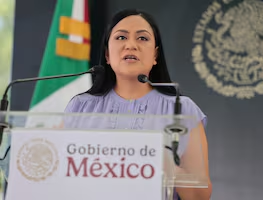Más Información

INE aprueba ampliación presupuestal de 9.2 mdp; se destinará para comprar chalecos en elecciones del Poder Judicial

Sheinbaum anuncia obras de infraestructura en Nayarit; destaca puente que irá de Bahía de Banderas a Puerto Vallarta y un acueducto

Detienen a presunto jefe de célula delictiva allegada a Los Chapitos; se encargaba de narcomenudeo y compra-venta de armamento

“¡Arráncate, Coalcomán!”; así fue la campaña de Anavel Ávila, presuntamente ligada al “Mencho”, para Movimiento Ciudadano

Presupuesto para programas sociales está asegurado en la Constitución: Ariadna Montiel; destaca que se benefician a 320 mil nayaritas

Sheinbaum anuncia construcción de Farmacias del Bienestar en 2025; asegura habrá medicamentos gratuitos para personas vulnerables
The government proposal led by President-elect Andrés Manuel López Obrador to reduce taxes in the border area will leave a vacuum of between 83 and 104 billion pesos , according to tax lawyers and specialists.
The plan of the future federal administration of Mexico is to decrease the value-added tax (VAT) from 16% to 8% , and income taxes (ISR) from 30% to 20% which, according to experts, could represent a potential risk of the area becoming a tax haven.
In view of this scenario, experts asked the President-elect to analyze and reconsider the proposal before it is taken into account as a reform initiative and part of the Federal Budget for 2019 .
The maximum potential loss in terms of taxes, as calculated by the Center of Economic and Budget Research (CIEP) , is similar to the budget meant for the Ministry of Social Development , which rose to 106.6 billion pesos in 2018 , while the minimum potential loss surpasses the total expenses of the Ministry of Communication and Transport (84.5 billion pesos) .
In attempts to stop the border area from representing a fiscal expenditure or tax loss, the head of CIEP, Héctor Villareal, has respectfully asked López Obrador to reconsider said proposal .
Through his social media, the director expressed that, whenever a country such as Mexico decides to cut taxes, it is unlikely for said adjustment to render a positive effect in the long run.
Facing these concerns, CIEP analyst Adrián García Gómez conducted a study on VAT and ISR tax collection in the border to assess the potential impact of AMLO’s policy.
“The proposal would leave an important vacuum in public finance, accentuated by socio-demographic changes, which also have budget implications regarding the increase of pensions and health expenses,” the document warns.
However, the study points out that the measure could indeed increase competitiveness in the border territory and attract larger investments and consumption
. According to Adrián García, the reduction of value-added taxes to 8% in the northern border would imply giving up on a maximum of 55.1 billion pesos in tax collection . He pointed out that the measure Mexico’s new government wants to implement is aimed at stimulating domestic consumption, which would represent a 6.9% decrease in product prices , thus compensating tax losses.
By reducing income taxes to 20%, the public budget would be short of a maximum of 49.2 billion pesos , García indicated, warning that the stimulus could exacerbate two major tax problems: evasion and avoidance ; the first is due to the frequency of lies in the registry of private sales sites, while the second is due to the change in tax addresses.
The chairman of the Mexican Public Accountants Institute (IMCP), José Besil , claimed that, although cuts in value-added taxes and income taxes in the border is a competitive strategy, the proposal will have to outline regulations to prevent said region from becoming a tax haven.
For their part, the Bank of Mexico (BANXICO) feels that an agreement between the president-elect and the state governors of the border area in northern Mexico to reduce VATs and income taxes could stimulate investment in said part of the country.
On September 13, the general director of Economic Research, Daniel Chiquiar , considered that the measure could increase competitiveness in the region.
dm





